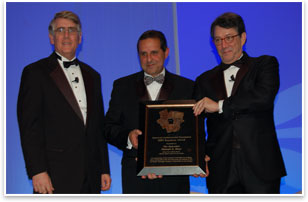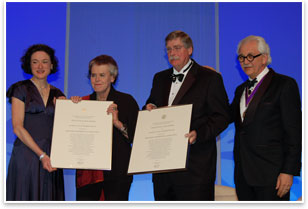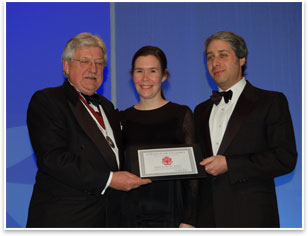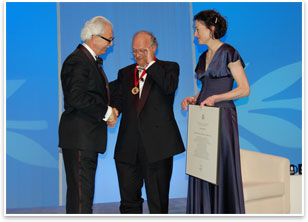Accent on Architecture: Accent on Sustainability and Excellence
Glenn Murcutt receives 2009 AIA Gold Medal, holds a conversation about sustainability with his many admirers
by Stephanie Stubbs, Assoc. AIA
Managing Editor
Summary: A brilliant array of architects and architecture-loving friends joined the American Architectural Foundation, in partnership with the AIA, for the 20th annual Accent on Architecture gala on February 6 at historic Constitution Hall in Washington, D.C. As has become tradition, the gala offered the opportunity to honor America’s architectural best and brightest. However, there were new twists to this year’s presentations: A theme—sustainability—and, to facilitate a greater engagement by the public in a conversation about design, a more informal venue through which Architectural Record Editor in Chief Robert A. Ivy, FAIA, engaged 2009 Gold Medal recipient Glenn Murcutt, Hon. FAIA, in a conversation using questions submitted by architects and the public via the AIA’s blog.
AAF Board of Regents Chair Sandy Diehl; AIA President Marvin J. Malecha, FAIA; and AAF President and CEO Ronald E. Bogle, Hon. AIA, warmly welcomed the guests and acknowledged this year’s sponsors. Then, highlighting the evening, came presentations of this year’s awards and the conversation with this year’s Gold Medal recipient.
 AAF Keystone Award: Miami Mayor Manuel A. Diaz AAF Keystone Award: Miami Mayor Manuel A. Diaz
Each year, the AAF presents the Keystone Award to an organization or individual from outside the architecture profession in recognition of exemplary leadership in the field of architecture and design. The 2009 Keystone Award was presented to Miami Mayor Manuel A. Diaz, who was nominated by the U.S. Conference of Mayors. Representing the conference, its CEO and Executive Director Tom Cochran, joined by noted architect Elizabeth Plater-Zyberk, FAIA, of Miami’s Duany Plater-Zyberk & Company, presented the award to Mayor Diaz. “Thanks for participating with me in Miami’s architectural journey,” the mayor said. He noted that every generation faces a collective challenge that defines it. As our parents and grandparents faced World War II to become known as the “Greatest Generation,” it is our turn to become known as the “Greenest Generation,” he said.
 AIA Twenty-five Year Award: Fanueil Hall AIA Twenty-five Year Award: Fanueil Hall
“Few treasures of Boston’s rich past have shown more brightly or taught more lessons about historic preservation as a strategy for urban sustainability than this year’s recipient of the AIA’s Twenty-five Year Award, Fanueil Hall Marketplace,” said AIA Executive Vice President/CEO Christine McEntee. Introducing the award was Sharon Park, FAIA, former National Park Service chief of technical preservation services, who noted that Fanueil Hall was the first historic preservation project awarded the Twenty-five Year Award. “This project envisioned the rest of our historic preservation projects,” she noted.
Jane Thompson, Assoc. AIA, of Thompson Design Group, Inc., and Philip Loheed, AIA, BTA Architects, Inc., accepted the award for Benjamin Thompson and Associates from Malecha.
 Latrobe Prize announced Latrobe Prize announced
“An important component of education is research. Architecture is, after all, a marriage of art and science. Created in 2000 by the AIA’s College of Fellows, the Latrobe Prize is the world’s most generous grant that advances the science of architecture,” McEntee said. She invited Chancellor of Fellows Donald L. Hackl, FAIA, to announce the recipients of the Latrobe Prize, a biennial $100,000 award from the AIA College of Fellows to support a two-year program of research selected by jury review. The 2009 Latrobe Prize is awarded to Martin Felsen, AIA, and Sarah Dunn for their proposal entitled “GROWING ENERGY/WATER; using the grid to get off the grid.”
AIA Architecture Firm Award: Olson Sundberg Kundig and Allen
The AIA Architecture Firm Award is the highest honor the AIA bestows on an architecture firm. Stephen Kieran, FAIA, partner in KieranTimeberlake (last year’s Architecture Firm Award recipient) introduced this year’s recipient, Olson Sundberg Kundig and Allen of Seattle. Jim Olson, FAIA; Rick Sundberg, FAIA; Tom Kundig, FAIA; and Scott Allen, AIA, along with their partners Alan Maskin; Kirsten Murray, AIA; and Stephen Yamada-Heidner, AIA, accepted the award on behalf of their firm.
 “Looking back, we know that none of our projects would have succeeded without the high aspirations and trust of our clients—and the dedication of our talented staff, our consultants, as well as the exceptional builders, craftspeople, inventors, and artists who add amazing richness to our work. We also want to recognize our families who share with us and share us with our demanding profession and give us such needed moral support,” Olson said. “Looking back, we know that none of our projects would have succeeded without the high aspirations and trust of our clients—and the dedication of our talented staff, our consultants, as well as the exceptional builders, craftspeople, inventors, and artists who add amazing richness to our work. We also want to recognize our families who share with us and share us with our demanding profession and give us such needed moral support,” Olson said.
Added Kundig: “One of our favorite natural theories is the notion of 'leap evolution'; that change happens suddenly, dormant systems unexpectedly change. It is in this spirit that we see this award as a touchstone and is now a call for us to leap to a new urgency of our systems that sustain us ... to risk ... to rethink.”
AIA Gold Medal: Glenn Marcus Murcutt, Hon. FAIA
In a time when architecture practice is all about collaboration, few individuals can claim sole and original authorship of a convincing body of significant architecture, noted Malecha. “However, there are exceptions. Standing tallest among them is this year’s recipient of the highest honor the AIA can bestow for a lifetime of individual achievement, the Gold Medal: Glenn Marcus Murcutt.”
 Murcutt joined McGraw-Hill Vice President, Editorial Director, and Architectural Record Editor in Chief Robert A. Ivy, FAIA, on stage for a more casual conversation, symbolic of the AIA’s and AAF’s desire to make the celebration of architecture more accessible to a broader, more diverse range of people. The conversation expanded into three topics dear to Murcutt’s heart: hand drawing, his sole practitionership that is limited to work in Australia, and green architecture. Murcutt joined McGraw-Hill Vice President, Editorial Director, and Architectural Record Editor in Chief Robert A. Ivy, FAIA, on stage for a more casual conversation, symbolic of the AIA’s and AAF’s desire to make the celebration of architecture more accessible to a broader, more diverse range of people. The conversation expanded into three topics dear to Murcutt’s heart: hand drawing, his sole practitionership that is limited to work in Australia, and green architecture.
Hand drawing: Ivy kicked off the talk by noting one of Murcutt’s signature characteristics in a day when computerized production seems to rule the profession: his drawing. “Why do you espouse commitment to hand drawing?” Ivy asked.
Murcutt explained that we all know that drawing, drawing out, means to bring out, which means to reveal, which means to understand. He recalled the answers of American poet Billy Collins, who revealed that he writes his poetry in longhand, because writing on a page gives a fluidity that allows the poem to be going on its own way.
“That’s like architecture,” Murcutt said. The design by hand-drawn line develops on its own. “One of the problems in schools is the exclusive use of the computer, which in fact, is only a tool,” Murcutt said. In hand drawing, the brain extends through the hand and the thinking shows on the paper, he noted.
Working alone in Australia: “You’ve chosen to work exclusively in Australia and alone,” Ivy said. “What are the advantages?”
Murcutt replied that, back in 1969, after a frustrating experience of working for someone else, he realized that he was nearly unemployable. “I realized that the most important thing is not to complain, but to get out there and do it yourself,” he said.
 He mentioned the early influences on his life of the writings of Henry David Thoreau and the importance of the individual and individual thinking. “The mass of men lead lives of quiet desperation,” he quoted from Walden. He mentioned the early influences on his life of the writings of Henry David Thoreau and the importance of the individual and individual thinking. “The mass of men lead lives of quiet desperation,” he quoted from Walden.
Murcutt said that in his experience, as architecture offices expand in size, the importance they afford to design lessens. Wanting to stay true to his design ideals, he stayed a sole practitioner. Rather than take on more people as the demand for his work grew, he instead took on time, he said. “Clients would wait three months,“ he noted. Then, they would wait six month, then a year … now, he has clients who are willing to wait up to three years for one of his designs. A side benefit, his office has almost no overhead and all of his work is profitable.
The architect has turned down many invitations to work in the United States. “I’m not ready to be sued,” he said. “And I’m not a control freak, but I need to control the quality of the project—my clients deserve that,” he said. “And I get to make the architecture the way I want.”
Sustainable materials: Ivy then played a video of students from the Washington, D.C., Phelps High School who fired a barrage of questions, many of which centered on: How do you create green buildings and sustainable architecture?” Ivy narrowed it down to: “How do material choices affect sustainable architecture?”
Murcutt says that his material of choice for sustainable buildings is wood. “I use it whenever I can; it comes as a priority,” he said. He noted also that beyond materials, how a building is assembled can create its sustainability. For instance, he uses bolts as connectors whenever possible instead of nails. He mentioned he happened to buy one of the houses that he had designed with bolts years earlier and how easy it was to do a major remodeling by unbolting and moving major pieces, including a veranda and the stairwells.
Sustainability can also be achieved through naturally directing and controlling air movement and natural light throughout the building, he noted. Whatever the chosen material or system, the effort must be true and sincere. “Greenwashing has no future,” he said.
On receiving the Gold Medal: “What were your thoughts on receiving the Gold Medal?” Ivy asked.
“I was in a state of shock,” Murcutt recalled of the morning when AIA President Marshall Purnell, FAIA, and nominator Tod Williams, FAIA, called to tell him the news. “Of course, it was 2:35 in the morning.”
 “I was staggered and I couldn’t believe it. I hadn’t thought of it—I’d rather fly under the radar. But when it happens, it’s beautiful. I am deeply honored,” he said. “I was staggered and I couldn’t believe it. I hadn’t thought of it—I’d rather fly under the radar. But when it happens, it’s beautiful. I am deeply honored,” he said.
After the conversation, Malecha bestowed the Gold Medal upon Murcutt, who was visibly touched by the crowd’s standing ovation for him. ”This is a totally incredible event … I am incredibly honored,” he said.
“In closing, let us consider the words spoken here in Washington just a few weeks ago by this country’s new president: ‘What is required of us now is a new era of responsibility, a recognition on the part of every American that we have duties to ourselves, our nation, and the world, duties that we do not grudgingly accept but rather seize gladly,’” Diehl told the audience. Malecha added: “The audacity of hope does not live somewhere else. It lives in each one of us.”
|



 AIA Twenty-five Year Award: Fanueil Hall
AIA Twenty-five Year Award: Fanueil Hall  Latrobe Prize announced
Latrobe Prize announced “Looking back, we know that none of our projects would have succeeded without the high aspirations and trust of our clients—and the dedication of our talented staff, our consultants, as well as the exceptional builders, craftspeople, inventors, and artists who add amazing richness to our work. We also want to recognize our families who share with us and share us with our demanding profession and give us such needed moral support,” Olson said.
“Looking back, we know that none of our projects would have succeeded without the high aspirations and trust of our clients—and the dedication of our talented staff, our consultants, as well as the exceptional builders, craftspeople, inventors, and artists who add amazing richness to our work. We also want to recognize our families who share with us and share us with our demanding profession and give us such needed moral support,” Olson said. Murcutt joined McGraw-Hill Vice President, Editorial Director, and Architectural Record Editor in Chief Robert A. Ivy, FAIA, on stage for a more casual conversation, symbolic of the AIA’s and AAF’s desire to make the celebration of architecture more accessible to a broader, more diverse range of people. The conversation expanded into three topics dear to Murcutt’s heart: hand drawing, his sole practitionership that is limited to work in Australia, and green architecture.
Murcutt joined McGraw-Hill Vice President, Editorial Director, and Architectural Record Editor in Chief Robert A. Ivy, FAIA, on stage for a more casual conversation, symbolic of the AIA’s and AAF’s desire to make the celebration of architecture more accessible to a broader, more diverse range of people. The conversation expanded into three topics dear to Murcutt’s heart: hand drawing, his sole practitionership that is limited to work in Australia, and green architecture. He mentioned the early influences on his life of the writings of Henry David Thoreau and the importance of the individual and individual thinking. “The mass of men lead lives of quiet desperation,” he quoted from Walden.
He mentioned the early influences on his life of the writings of Henry David Thoreau and the importance of the individual and individual thinking. “The mass of men lead lives of quiet desperation,” he quoted from Walden. “I was staggered and I couldn’t believe it. I hadn’t thought of it—I’d rather fly under the radar. But when it happens, it’s beautiful. I am deeply honored,” he said.
“I was staggered and I couldn’t believe it. I hadn’t thought of it—I’d rather fly under the radar. But when it happens, it’s beautiful. I am deeply honored,” he said.